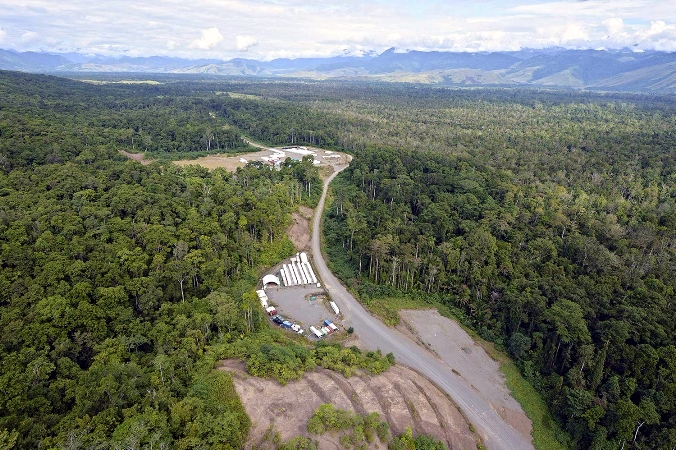By CHRISTOPHER YANDAWAI
DESPITE Morobe Provincial Government’s ongoing opposition on the Deep Sea Tailings Placement (DSTP) of the proposed Wafi-Golpu project, the developer wants to progress with the project.
Wafi-Golpu Joint Venture (WGJV) being the developer of Wafi-Golpu project claims that DSTP was the safest and most environmentally and socially responsible solution for the project and looks forward to progressing the permitting of the project soon.
The company told PNG Bulletin on Friday that it stands behind the rigour of its extensive technical and scientific studies, and the findings of its Environment Impact Study (EIS) to progress the permitting exercise as soon as practicable under the Mining Act 1992.
The company was responding to media queries sought by this paper seeking clarifications on the company’s position involving the ongoing DSTP issue and also what other option that the company was considering in consultation with the National Government apart from DSTP.
In response, the company said on the basis of technical and scientific studies costing over K75 million, it is confident that DSTP was the safest and most environmentally and socially responsible solution for the Wafi-Golpu project.
The company said the decision to select DSTP for tailings management at the proposed Wafi-Golpu mine was made following years of investigation, including more than 10 years of studies into 45 possible land-based tailings storage site options, at a cost of over K15 million.
“These studies have been independently verified as having been conducted in accordance with appropriate industry professional standards,” the company said.
It further explained that after years of extensive technical and scientific studies, WGJV has not identified a viable land-based tailings storage site option for the life of the proposed Wafi-Golpu mine that provides acceptable levels of risk and complies with applicable international standards.
The company highlighted challenges that it faced in the process of identifying a potential location for tailings.
“Due to a combination of environmental, cultural heritage, engineering, construction and seismological factors, each identified potential location was determined to have an unacceptable level of residual risk after implementation of all possible risk mitigation and controls.
“This assessment was documented in Chapter 7 (Alternatives) of the Wafi-Golpu Environmental Impact Statement (EIS) which was submitted to the Conservation and Environmental Protection Authority (CEPA) in June 2018 in accordance with PNG guidelines, policy and law and where relevant, international standards and best practice,” the company explained.
It further explained that the WGJV commenced detailed DSTP studies in 2016 after identifying these significant safety, environmental and social challenges to on-land tailings management solutions.
As a result of the company’s studies, it was identified that the Markham Canyon in the Huon Gulf was an ideal location for DSTP as it forms a continuation of the Markham River, which in its normal course annually transports significant amounts of natural river sediment into very deep water.
“The WGJV’s evaluation of a DSTP option was undertaken in accordance with the Draft DSTP Guidelines for PNG. As part of the rigorous Environmental Assessment of the Project’s EIS, CEPA engaged three Independent Peer Reviewers. The EIS was also reviewed by the independent expert Environment Council,” the company said.
It said WGJV and CEPA have had an ongoing engagement with the Project Impact Area and coastal communities regarding the Project and in particular tailings management.
“WGJV has conducted nearly 900 stakeholder engagements, involving over 32,000 participants, since January 2016 and continues today with a further round of engagements planned in mid-February.”
The company also highlighted that it has welcomed the Conservation & Environment Protection Authority’s (CEPA’s) issue of an Environment Permit for the Wafi-Golpu project and notes this was granted after CEPA conducted a rigorous process of environmental impact assessment in accordance with the Environment Act.
“The Environment Permit approves Deep Sea Tailings Placement (DSTP) as the tailings management method for the Project for the life of the mine.”
“Although, WGJV was disappointed by Governor Saonu’s dismissal of the science underpinning the Project Environment Impact Study and the basis for DSTP, the company looks forward to progress the permitting of the project soon.”
Meanwhile, Morobe Governor Ginson Saonu has issued 14 days ultimatum to Prime Minister James Marape and the National Executive Council to revise its decision to grant an Environmental Permit to Wafu-Golpu Joint Venture.
The ultimatum was issued in Lae at the conclusion of the NO DSTP public forum that he organised at the Sir Ignatius Kilage Stadium last Thursday.
Prime Minister James Marape who gave guarantee to have this project get off the ground as soon as possible is yet to respond to the issue of DSTP as well as the 14 days ultimatum issued by Governor Saonu.

